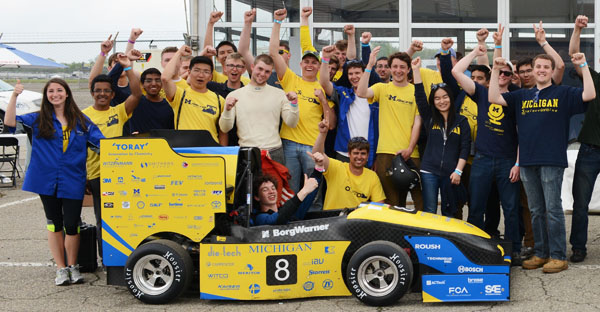
The U-M Formula SAE team, MRacing, went into the 2014-’15 season with two clear goals: reduce the overall mass of its vehicle, MR-15, and finish in the top five at competition.
The team accomplished both.
Vehicle weight dropped from 468 pounds in 2014 to 419 pounds for MR-15, more than a 10 percent reduction. And the team finished fifth at FSAE Michigan, held at the Michigan International Speedway (MIS) in Brooklyn. It was the team’s best finish since the 2012 season.
“The 2015 team was comprised of mostly sophomores, and having such a young team meant a steep learning curve. Going forward the experience from this year will make the team even stronger,” said Keenan Temin, 2016 MRacing captain.
Temin credits the team’s success in part to an overall improvement in its business, cost and design presentations at competition as well as a number of new design features.
The most notable design feature was an extensive new aerodynamics package, necessitated by a FSAE rule change.
“Even though our [new] wings are smaller, our aero team was able to create a more efficient design, maintaining similar downforce numbers as in previous years while also weighing significantly less,” noted Temin.
The team verified its design work by taking the car to Fiat Chrysler Automobiles’s wind tunnel and correlating its simulations to the data gathered during testing.
“The rule changes really encouraged us to think and experiment with new design and fabrication techniques,” said Temin. “Although the experience tested our team’s abilities, we were able to pull it off by sticking to our schedule and staying motivated.”
Other design changes included integrating a new pneumatic shifting system that allowed the car to auto shift during straight-line acceleration events. On the engine side of design and development, the team used its dynamometer and custom-profiled camshafts to determine a better setup for its application.
Team alumni also pitched in and gave the team valuable feedback during the annual design review, held each September.
“The team turns over every four years, which means there is a huge opportunity for knowledge to get lost,” Temin explained. “Getting input from our team alums, where they give us feedback based on their experience on the team and also from their time in industry is incredibly helpful.”
Looking ahead, the team plans to spend even more time on backend design and testing, since its testing time proved extremely beneficial last year.
“If we can have six weeks of testing time before our first competition, we’ll be able to tune our car, gather useful data and have an overall better performance at competition,” said Temin.
Like last year, Temin and the team are clear about its goal going forward: “build a faster, more innovative racecar. A top-three finish at MIS and a top-five finish at Formula Student Germany in 2016 will prove that we accomplished just that.”